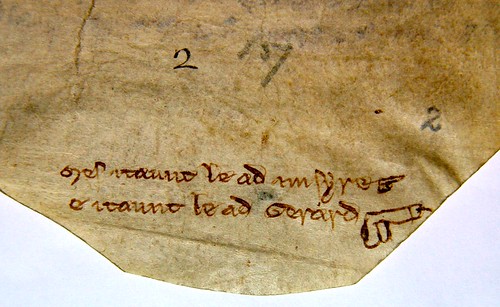
Marginalia in a copy of Livy’s Historiae Romanae (Venice, 1470), one of the illustrations in a long New York Review of Books piece about marginalia, a topic dear to my heart as the first thing I ever blogged about, the original title of this blog, and the name of the Madison-like city in a book I never wrote.
ADDED: One of my favorite old post titles is "Genitalia marginalia," which has this memorable photograph:





8 comments:
Interesting re marginalia.
I love finding things like this.
I once had the rather creepy experience of finding a note from my recently deceased uncle in a book I found in our university library. Orwells Catalunya as it happens.
Livy's history is interesting on many levels. One topical one is the purpose of history, which in his case was openly political and ideological. There is such an argument going on right now about the teaching of US history, as it relates to the Common Core standards. And that brings us to the coming elections, as this is, justly, a controversial matter on the Right, and one, perhaps minor, complaint about Jeb Bush.
The most interesting marginalia I ever heard of was in the world of mathematics.
Specifically, Fermat's last theorem.
What is odd is that Fermat was probably wrong about his elegant little proof. The theorem was proved, eventually, but the proof is not short...
@SJ The NYRB article is about insults and negative things in margins, but it got me wondering about the most famous/greatest marginalia, and I too thought of Fermat's last theorem. I also did some research and saw that Voltaire's marginalia are a big deal. There's a lot of it, and he used the margins of his books to have some place to write when he was in prison.
@Bob
Thanks!
The Kindle tools that allow highlighting and notes are nice but no substitute for drawing dicks and tits in the margins
It's my understanding that the phallic symbol (with wings) was in fact a common religious/good luck charm in ancient Rome. People wore them around their neck like a cross is worn today?
I am not sure if it is due for a comeback though....
Heh....good luck charm you say?
I had a friend (I'll call him "Russ")in college who always left me a note when he'd stop by my room and the note always had one of those good luck charms at the bottom. I always knew "Russ" had stopped......so did my girl friend after reading enough of them when she'd knock on my door. My Dad stopped to visit and also got to see some of "Russ'" good luck charms. Still makes me laugh thinking about it.
Did you ever read "The Book Nobody Read."
It is about "de Revolutionibus" Copernicus book.
From my review in 2004:
67 of 68 people found the following review helpful
An introduction to bibliophilia
By Michael T Kennedy VINE VOICE on March 15, 2004
Format: Hardcover Verified Purchase
The story of Copernicus and his description of the heliocentric universe forms the background of this fascinating book. The scientific revolution began with Copernicus. Owen Gingerich is an astrophysicist and historian of science who began his whimsical quest in 1970 as part of the preparation for the 500th anniversary of Copernicus birth in 1973. International scholarly celebrations were planned and Gingerich was on the committee to prepare them. The question arose whether many owners of the book had actually read all the way through this massive and rather tedious tome. Gingerich happened to be visiting Scotland at the time and decided to look at a copy of "De revolutionibus," known to be in the Royal Observatory in Edinburgh. To his surprise, the copy was heavily annotated all the way through.
It had been read and others had made notes in the margins.
Post a Comment
Please use the comments forum to respond to the post. Don't fight with each other. Be substantive... or interesting... or funny. Comments should go up immediately... unless you're commenting on a post older than 2 days. Then you have to wait for us to moderate you through. It's also possible to get shunted into spam by the machine. We try to keep an eye on that and release the miscaught good stuff. We do delete some comments, but not for viewpoint... for bad faith.